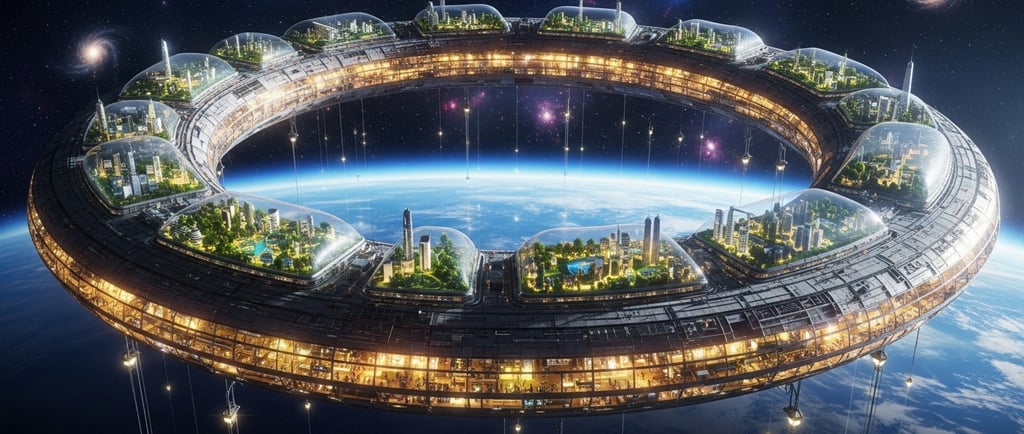So, Where Do You Wanna Be? A Vision of Humanity’s Future Homes
Embark on a visionary journey to humanity’s future homes, from underwater aquariums to lunar bases, orbital rings, floating space stations, and walking cities. This piece explores how technological innovation might address resource shortages and population pressures, blending futuristic concepts with human needs, offering a glimpse into where we might live next.
URBAN PLANNINGFUTURETECHNOLOGYINNOVATION
Suraj Prasad
8/3/20253 min read


Ever since humans first walked this planet, we’ve dreamed of new worlds—places distant, unusual, and exciting. I don’t fully get the thrill myself, but I see why folks imagine living under the sea or on Mars. Familiarity can breed contempt, and over time, we humans often crave something different. But this isn’t a philosophy chat—it’s time to explore where humanity might live next, blending imagination with what’s probable as our world changes.
The Push for New Frontiers
As we march forward, we face growing challenges: water shortages, resource scarcity, and population pressures. All the sci-fi wonders we’ve dreamed up might just become reality. In fact, we’ll need to adapt, building new architectures beyond Earth’s land, exciting, right? Let’s dive into some wild ideas that could shape our future homes.
Living Under the Sea: High-Tech Aquariums
Picture this: a high-tech aquarium, massive and livable, nestled on the ocean floor. Concepts like permanent underwater homes aim for self-sustaining bubbles with direct ocean access for diving, powered by renewable energy, and focused on ocean exploration. These modular stations could house families, researchers, and workers, with seafood farms right outside your window and protection from surface storms. The perks are huge, but challenges like pressure, isolation, and limited space for growth make it tricky.
Lunar Settlements: Moon Bases of the Future
Straight out of space agency dreams, lunar settlements could rise with habitats built from moon dirt for radiation shielding. Think inflatable domes or underground modules for small crews, complete with greenhouses and life support. By mid-century, we might even use mushroom-based materials for construction. Self-sufficiency near the lunar south pole, where water ice is plentiful, is the goal, but it’s harsh: no atmosphere, extreme temperatures, and long trips from Earth.
Orbital Ring Around Earth: A Cosmic Hula Hoop
Imagine a massive ring orbiting Earth, a million miles wide, offering hundreds of times more living space than our planet. This artificial ring in low orbit would spin for artificial gravity, linked to Earth via space elevators for easy access. Picture cylinder habitats forming rings with cities, farms, and energy solutions. It could slash space travel costs like airplane tickets and even help with climate control. Building it would be a mega-feat, but it’s a game-changer.
Floating Space Stations: Inflatable Orbiting Homes
Think of super-sized upgrades to current orbital labs: giant, inflatable habitats drifting in orbit or deep space. Designs include expandable stadium-sized bubbles that inflate in space, with double walls for radiation protection, hydroponic farms, and room for long-mission crews. They could form rotating cylinders for gravity, offering flexibility and lightweight launches. But they’re vulnerable to debris and rely on resupplies.
Giant Walking Cities: Nomadic Robotic Wonders
Here’s some retro-futurism with a twist: massive, insect-like robotic cities on legs roaming land or sea, plugging into resources wherever they go. These self-sustaining arks could move to avoid disasters or chase opportunities, with modular buildings walking on tracks. Inspired by relocation freedom, modern takes include shape-shifting structures into domes or blocks. It’s energy-hungry and complex, but fun.
Evaluating Human Needs
Human interaction thrives in larger, dynamic setups like the orbital ring or walking city, where diverse communities form. Farming struggles in space or on the moon due to gravity and resources, but underwater wins with marine abundance. Communication is easiest near Earth, while travel favors mobile or connected designs: rockets are a hassle! If I had to pick, the orbital ring around Earth stands out, balancing huge populations, gravity-assisted farming, instant comms, and elevator travel. It’s not without hurdles, but it feels like humanity’s ultimate upgrade. The walking city is a close, adventurous second.
To elaborate on how I scored each out of 20, I considered four key human needs: human interaction (tight-knit communities vs. isolation), farming (resource availability for food), communication (ease of connecting internally and externally), and travel (mobility for exploration or relocation). Each category gets up to 5 points—low (1-2), medium (3), high (4-5)—totaling the score. For under the sea: medium interaction (tight groups but isolated), high farming (marine resources), medium communication (good internally but depth delays external), low travel (limited by subs)—13/20. Moon base: low interaction (small crews), medium farming (greenhouses), low communication (Earth delays), low travel (rockets)—9/20. Orbital ring: high interaction (vast communities), high farming (gravity aids agriculture), high communication (near-Earth networks), high travel (elevators)—18/20. Floating station: medium interaction (rotations help), medium farming (hydroponics), medium communication (orbit delays), medium travel (docking)—12/20. Walking city: high interaction (urban scale), medium farming (portable but terrain-limited), high communication (Earth-based), high travel (mobile)—16/20.


Suraj Prasad
Engineer at Esko
